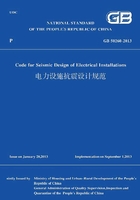
1 General Provisions
1.0.1 This Code is developed in accordance with the Law of the People s Republic of China on Protecting Against and Mitigating Earthquake Disasters following the policy of"prevention oriented,combination of prevention and relief",with a view to minimizing earthquake disasters of electrical installations,preventing personal injury and death,and reducing economic loss after taking seismic measures.
1.0.2 This Code is applicable to the seismic design of the following electrical installations newly built,expanded or modified in areas with a seismic precautionary intensity of 6 to 9 degrees:
1 Electrical installations in fossil fuel power plants with a unit capacity of 12-1000MW;
2 Relevant electrical facilities in hydropower plants with a unit capacity of 10MW and above;
3 Electrical installations in AC transmission projects with a voltage class of 110-750kV;
4 Electrical installations in DC transmission projects with a voltage class of±660kV and below;
5 Power system communication microwave towers and their foundations.
1.0.3 Newly built,modified and expanded electrical installations must meet seismic precautionary requirements.
1.0.4 Electrical facilities designed in accordance with this Code shall maintain in normal service without being damaged in the event of an earthquake with an intensity equal to or smaller than the seismic precautionary intensity of the local area.Also,these electrical facilities shall not be severely damaged and can be restored to normal service after repair in the event of a rare earthquake with an intensity greater than the seismic precautionary intensity of the local area.
1.0.5 For structural members of buildings(structures)for electrical installations designed in accordance with this Code,they shall not be damaged or shall maintain in normal service without repair in the event of a frequent earthquake with an intensity smaller than the seismic precautionary intensity of the local area;they may be damaged but can be restored to normal service after general repair or without repair in the event of an earthquake with an intensity equal to the seismic precautionary intensity of the local area;they shall not collapse or suffer life-threatening severe damage in the event of a rare earthquake with an intensity higher than the seismic precautionary intensity of the local area.
1.0.6 Electrical installations shall be classified into important ones and common ones by the importance and characteristics of seismic protection,and shall comply with the following provisions:
1 Those satisfying one of the following terms are deemed as important electrical installations:
1)Fossil fuel power plant with a unit capacity of 300MW and above or with a planned capacity of 800MW and above;
2)Captive power plant of industrial and mining enterprises where an outage will cause severe damage to important equipment or endanger personal safety;
3)Hydropower plant with a design capacity of 750MW and above;
4)220kV hub substations,330-750kV substations,330kV and above converter stations,500-750kV large-crossing towers,and±400kV and above large-crossing towers;
5)Power system communication facilities that shall in no case be interrupted;
6)Other important electrical installations that must maintain normal power supply during an earthquake as approved by the competent organization.
2 Electrical installations other than important ones are common electrical installations.
1.0.7 Buildings(structures)of electrical installations are classified into three categories by importance and shall comply with the following provisions:
1 Category B is major seismic precautionary category,including buildings(structures)of power plants and power supply buildings(structures)of transmission projects which are classified as important electrical installations.
2 Category C is standard seismic precautionary category,including buildings(structures)of common electrical installations,buildings(structures)housing continuous production equipment,as well as public buildings(structures)and important material warehouses.
3 Category D is appropriate seismic precautionary category,including buildings(structures)other than Category B and Category C buildings(structures).
1.0.8 The seismic ground motion parameters or seismic precautionary intensity of electrical installations must be determined in accordance with the national specified approvals and documents(drawings)issued.
1.0.9 The seismic precautionary intensity or ground motion parameters of electrical installations shall be determined in accordance with the current national standard Seismic Ground Motion Parameters Zonation Map of China GB 18306.For sites on which seismic safety evaluation has been made as per relevant provisions,seismic protection shall be made in line with approved design ground motion parameters or corresponding intensity.For electrical facilities classified as important electrical installations,an intensity of 1 degree higher than the seismic precautionary intensity may be adopted,except that the seismic precautionary intensity is 9 degree and above.
1.0.10 The seismic precautionary criteria for buildings(structures)of various seismic precautionary categories shall comply with the current national standard Standard for Classification of Seismic Protection of Building Constructions GB 50223.
1.0.11 The need for adopting an intensity of 1 degree higher than the seismic precautionary intensity for important large-crossing towers and foundations of overhead transmission lines shall be reviewed by experts and subject to approval by the superior organization.
1.0.12 In addition to this Code,the seismic design of electrical facilities and buildings(structures)of electrical installations shall comply with applicable national standards currently in force as well.